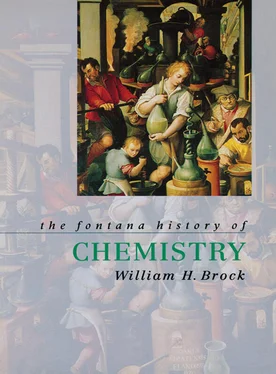Enough had been done, however, to convince Lavoisier that Eller’s contention that water could be transmuted into earth was nonsense. This was reported to the Academy in 1770. He also surmised, under the influence of Venel’s views on the chemical dissolution of air in liquids and solids, that there was a more plausible explanation of water’s apparent change into vapour or air when heated – namely, that heat, when combined with water and other fluids, might expand their parts into an aerial condition. Conversely, when air was stripped of its heat it lost its voluminous free aerial state and collapsed into, or was ‘fixed’ into, a solid or liquid condition, just as Stephen Hales had found in the 1720s when analysing the air content of minerals and vegetables.
Lavoisier recorded these ideas in an unpublished essay on the nature of air in 1772. Here was the basis for a theory of gases – though at this juncture Lavoisier knew nothing at all of the work of Priestley and others on pneumatic chemistry. He was also, not surprisingly, still interpreting his model of the gaseous state in terms of phlogiston. When air was fixed 1 :
… there had to be a simultaneous release of phlogiston or the matter of fire; likewise when we want to release fixed air, we can succeed only by providing the quantity of fire matter, of phlogiston, necessary for the existence of the gaseous state [ l’état de fluide en vapeurs ].
Lavoisier was now clear that there were three distinct states of matter 2 :
All bodies in nature present themselves to us in three different states. Some are solid like stones, earth, salts, and metals. Others are fluid like water, mercury, spirits of wine; and others finally are in a third state which I shall call the state of expansion or of vapours, such as water when one heats it above the boiling point. The same body can pass successively through each of these states, and in order to make this phenomenon occur it is necessary only to combine it with a greater or lesser quantity of the matter of fire.
Moreover, it followed from the fact that metals disengaged ‘air’ when they were calcined, that metals contained fixed air:
Apparatus for the preparation, collection and study of gases was a necessary factor in the chemical revolution. It was not until 1727 that Stephen Hales hit upon a way to isolate the ‘air’ produced from a heated solid. In order to estimate as accurately as possible the amount of ‘air’ produced and to remove any impurities from it, Hales ‘washed’ his airs by passing them through water before collecting them in a suspended vessel by the downward displacement of water.
Hales, like John Mayow in the seventeenth century, still thought in terms of a unique air element, but Joseph Black’s demonstration that ‘fixed air’ (carbon dioxide) was different from ordinary air encouraged Henry Cavendish, Joseph Priestley and others to develop Hales’ apparatus to study different varieties of air – or gases, as Lavoisier was to call them. An incentive here was the invention of soda water by Priestley, which encouraged interest in the potentially health-giving properties of artificial mineral waters generally. In 1765, while investigating spa waters, the English doctor, William Brownrigg, invented a simple shelf with a central hole to support a receiving flask or gas holder. This creation of the ‘pneumatic trough’ enabled gas samples to be transferred from one container to another and for gases to join solids and liquids on the chemical balance sheet.
Joseph Priestley (1733–1804) is surely one of the most engaging figures in the history of science. The son of a Yorkshire Congregational weaver and cloth-dresser, Priestley was trained for the Nonconformist ministry at a Dissenting academy in Daventry. Like most Nonconformist academies of the period, this taught a wider curriculum than the universities that included the sciences. After serving a string of ministries, where his theological views became increasingly Unitarian, and a teaching post at the famous Warrington Academy, in 1773 Priestley became the librarian and household tutor of William Petty, the second Earl of Shelburne who, while Secretary of State in Chatham’s cabinet, had opposed George III’s aggressive policy towards American colonists. Already the author of innumerable educational works, in 1767 Priestley had published a History and Present State of Electricity , which launched him upon a part-time career in science. While minister of a Presbyterian congregation at Leeds, and living next door to a brewery, Priestley had begun investigating the preparation and properties of airs. Under Shelburne’s patronage, Priestley had the necessary leisure to prepare some five volumes containing detailed accounts of these experiments on airs, as well as a number of theological works. There was a connection here in that Priestley was attempting to explore the relationship between matter and spirit.
In 1780, retaining a life annuity from Shelburne, Priestley returned to the ministry at Birmingham’s New Meeting. Here he found convivial philosophical and scientific company in the Lunar Society composed of rising industrialists and intellectuals such as Mathew Boulton, James Watt, Josiah Wedgwood and Erasmus Darwin. Although its members were united in their support for the American War of Independence and for the initial stages of the French Revolution, it was Priestley the preacher-orator who was publicly identified with radical criticism of English politics and the discrimination against Dissenters. In 1791 a ‘Church and King’ mob destroyed Priestley’s home and chapel, forcing him to flee to London. Although he was eventually compensated for the loss of his property, in 1794 he decided to emigrate and to join two of his sons in America.
Here he was warmly welcomed in Philadelphia, where he was offered the Chair of Chemistry at the University of Pennsylvania. Instead, Priestley moved to Northumberland, in rural Pennsylvania, where he hoped to found an academy for the sons and daughters of political refugees who would join him there. It did not work out and Priestley spent his declining years cut off by distance from European, and even American, intelligence, and fighting a rearguard action against Lavoisier’s chemistry in his fascinating Considerations on the Doctrine of Phlogiston (1796). Although outmanoeuvred by Lavoisier, Priestley lived on in two ways. His young executor, Thomas Cooper (1759–1839), a fellow refugee from English politics, acquired sufficient up-to-date knowledge of chemistry from studying in Priestley’s library and laboratory to become one of America’s leading chemical educators. A century after Priestley’s discovery of oxygen, in August 1874, a national meeting of chemists, gathered at his home in Northumberland (now a Priestley Museum), decided to create the American Chemical Society.
It was Cavendish who began the collection of water-soluble gases over mercury, but Priestley who brought their study and manipulation to perfection. Curiously, believing that chemistry, like physics, required expensive and complicated instruments, Lavoisier only rarely used the pneumatic trough; instead, he developed an expensive and sophisticated gasometer. A good third of Lavoisier’s Elements of Chemistry was devoted to chemical apparatus. Until the appearance of Michael Faraday’s Chemical Manipulation in 1827, Lavoisier’s descriptions remained the bible of instrumentation and chemical manipulative techniques.
In the spring of 1772, Lavoisier read an essay on phlogiston by a Dijon lawyer and part-time chemist, Louis-Bernard Guyton de Morveau (hereafter Guyton) (1737–1816). In a brilliantly designed experimental investigation, Guyton showed that all his tested metals increased in weight when they were roasted in air; and since he still believed that their combustibility was caused by a loss of phlogiston, he saved the phenomena by supposing that phlogiston was so light a substance that it ‘buoyed’ up the bodies that contained it. Its loss during decomposition therefore caused an increase of weight. Most academicians, including Lavoisier, thought Guyton’s explanation absurd. Following his previous reflections on the role of air, Lavoisier speculated immediately that a more likely explanation was that, somehow, air was being ‘fixed’ during the combustion and that this air was the cause of the increase in weight. It followed that ‘fixed air’ should be released when calces were decomposed – just as Hales’ earlier experiments in Vegetable Staticks had suggested.
Читать дальше












